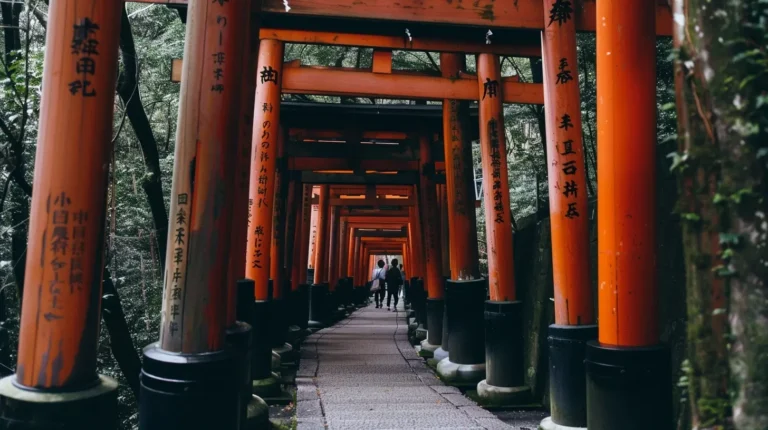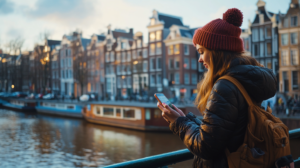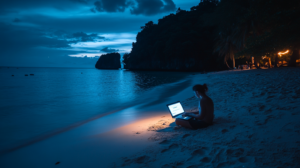Introduction
Hello, fellow wanderers! Imagine embarking on a journey where every detail of your travel aligns perfectly with your tastes, interests, and whims. That’s exactly what I experienced on my recent trip to Japan, thanks to the best AI for travel planning. Let me take you on a digital tour of the Land of the Rising Sun, where tradition meets futuristic innovation.
I’ve always been fascinated by Japan’s blend of ancient tradition and cutting-edge technology, so it seemed only fitting to plan my trip there using the latest in AI travel technology from EasyTrip.AI. As a tech enthusiast and a seasoned traveler, I was eager to see how well AI could craft a journey that felt both personal and effortless.
Detailed Daily Itinerary
Day 1: Tokyo’s Tech and Temples
Arriving in Tokyo, the AI had already suggested a morning visit to the historic Asakusa Temple followed by an afternoon exploring Akihabara’s electronic shops. The AI’s ability to gauge my morning preference for culture and afternoon tech-browsing was impressive, making the first day a perfect blend of old and new.
After landing at Haneda Airport, I swiftly moved to my hotel in the Shinjuku area, thanks to the AI’s pre-arranged transportation. The day began at Senso-ji, Tokyo’s oldest temple. The AI had timed my visit to coincide with the temple’s morning rituals, offering an immersive cultural experience. I wandered through the Nakamise Shopping Street leading up to the temple, sampling traditional snacks like taiyaki and senbei.
In the afternoon, the AI guided me to Akihabara, Tokyo’s famed electronics district. I explored multi-story stores filled with the latest gadgets, anime merchandise, and retro video games. The AI had pinpointed specific shops based on my interests, such as Super Potato for vintage gaming consoles and Yodobashi Camera for the newest tech.
Dinner was at Gonpachi, famously known as the “Kill Bill” restaurant. The AI had reserved a spot for me, ensuring I enjoyed a delightful meal of yakitori and tempura in a setting that combined traditional ambiance with pop culture flair.
Day 2: Culinary Explorations in Tokyo
Food is a big part of why I travel, and the AI didn’t disappoint. It booked me a sushi-making class followed by a tour of the famous Tsukiji Fish Market. Every meal and experience was tailored to my love of seafood, enhancing my culinary journey through Japan’s capital.
The day began with a hands-on sushi-making class at Tokyo Sushi Academy. Guided by a professional sushi chef, I learned the art of making nigiri and maki rolls. The AI had selected this class for its excellent reviews and the intimate experience it offered. The fresh ingredients and expert instruction made for an unforgettable morning.
Post-class, I headed to Tsukiji Outer Market, where the AI had arranged a guided tour. My guide led me through bustling stalls filled with fresh seafood, explaining the market’s history and significance. I sampled delicacies such as uni (sea urchin) and toro (fatty tuna), recommended by the AI for their high quality.
Lunch was at Sushi Dai, a tiny but renowned sushi spot near the market. The AI had secured a reservation, allowing me to bypass the long wait. The omakase (chef’s choice) menu was a culinary revelation, each piece of sushi a perfect balance of flavor and texture.
In the evening, the AI suggested a visit to Omoide Yokocho (Memory Lane) in Shinjuku, a narrow alleyway lined with tiny eateries. I enjoyed yakitori (grilled chicken skewers) and sake, surrounded by locals and the nostalgic atmosphere of post-war Japan.
Day 3: Bullet Train to Kyoto
The AI seamlessly booked a bullet train to Kyoto, offering me a choice of seats based on my preference for window views. In Kyoto, it scheduled a late afternoon visit to Fushimi Inari Shrine, avoiding the crowds and capturing the perfect sunset moments through the Torii gates.
My journey on the Shinkansen from Tokyo to Kyoto was smooth and efficient. The AI had chosen a seat on the right side of the train, providing spectacular views of Mount Fuji along the way. Upon arrival in Kyoto, I checked into a traditional ryokan (inn) in the Gion district, complete with tatami mats and a serene garden.
In the late afternoon, I visited Fushimi Inari Taisha, famous for its thousands of red torii gates. The AI’s timing was impeccable; the crowds had thinned, and the lighting was perfect for photography. I followed the winding path up the mountain, passing through tunnels of torii gates, each donated by individuals and businesses. The hike offered both tranquility and stunning views of Kyoto below.
Dinner was a kaiseki (multi-course) meal at Kikunoi, a Michelin-starred restaurant. The AI had arranged the reservation well in advance, ensuring a seamless dining experience. Each dish was a work of art, reflecting the seasons and the refined culinary traditions of Kyoto.
Day 4: The Zen of Kyoto
AI planned a day visiting various Zen gardens and temples, including the Golden Pavilion. It knew my interest in photography and scheduled visits during the optimal lighting conditions, proving its attention to detail that no traditional travel agent has ever matched.
The day began with a visit to Kinkaku-ji (Golden Pavilion). The AI had advised an early arrival to capture the temple’s golden reflection on the pond in the morning light. The serene beauty of the pavilion and its surroundings made for stunning photographs.
Next, I visited Ryoan-ji, home to Japan’s most famous rock garden. The AI provided background information on Zen philosophy and the garden’s design, enhancing my appreciation of the minimalist landscape. Sitting quietly, I contemplated the arrangement of rocks and raked gravel, finding a sense of peace.
Lunch was at Shoraian, a restaurant in the Arashiyama district known for its tofu cuisine. The AI’s recommendation did not disappoint; the meal was exquisite, showcasing the delicate flavors of yudofu (boiled tofu) and goma-dofu (sesame tofu).
In the afternoon, I explored the Arashiyama Bamboo Grove and the nearby Tenryu-ji temple. The AI had optimized my itinerary to avoid peak times, allowing me to enjoy the bamboo forest’s ethereal beauty in relative solitude. The temple’s garden, designed by the famous landscape architect Muso Soseki, was a masterpiece of Japanese garden design.
Dinner was at Gion Nishikawa, another Michelin-starred establishment. The AI’s meticulous planning ensured a reservation and a delightful dining experience. The seasonal kaiseki menu, featuring locally sourced ingredients, was a culinary journey through the flavors of Kyoto.
Day 5: Nara’s Deer and Daimonji
A day trip to Nara was next. Here, the AI surprised me with a deer-feeding experience, followed by a hike up Mount Wakakusa for a breathtaking view of the city. The hike timing was perfect, as the path was less crowded and the weather was ideal.
Upon arriving in Nara, I headed to Nara Park, home to hundreds of free-roaming deer. The AI had suggested purchasing special deer crackers, allowing me to feed and interact with these friendly creatures. The deer, considered sacred messengers of the gods, were charming and playful, making for a delightful morning.
Next, I visited Todai-ji, one of Japan’s most significant temples and home to the Great Buddha statue. The AI had arranged a guided tour, providing deep insights into the temple’s history and architecture. The sheer size and grandeur of the Great Buddha were awe-inspiring.
Lunch was at Edogawa Naramachi, a restaurant specializing in unagi (grilled eel). The AI’s recommendation was spot-on; the tender eel, glazed with a sweet-savory sauce, was a highlight of my culinary journey.
In the afternoon, I embarked on a hike up Mount Wakakusa. The AI had chosen the optimal time for the hike, ensuring pleasant weather and fewer crowds. The panoramic views of Nara from the summit were breathtaking, and I spent some time soaking in the serene landscape.
Returning to Kyoto in the evening, I witnessed the Daimonji festival, where giant bonfires in the shape of kanji characters are lit on the mountains surrounding the city. The AI had secured a vantage point at Shogunzuka Seiryuden temple, offering an unparalleled view of the illuminated mountains.
Day 6: Osaka’s Nightlife
As someone who loves a vibrant nightlife, I was thrilled when the AI suggested Dotonbori in Osaka. It booked me a street food tour that included tasting takoyaki—octopus balls—a local delicacy, followed by a river cruise under the neon lights of the city.
Arriving in Osaka, I checked into my hotel in the Namba district, close to the bustling streets of Dotonbori. The AI had arranged a street food tour with a local guide, starting with the famous Kuromon Ichiba Market. I sampled takoyaki, okonomiyaki (savory pancakes), and kushikatsu (deep-fried skewers), each dish a testament to Osaka’s rich culinary heritage.
In the evening, I explored Dotonbori, famous for its neon lights and vibrant atmosphere. The AI had pre-booked a river cruise on the Tombori Riverwalk, providing a unique perspective of the district’s iconic landmarks, including the giant Glico Running Man sign and the animatronic crab at Kani Doraku.
Dinner was at Harukoma Sushi, a local favorite known for its fresh and affordable sushi. The AI’s recommendation ensured a delicious and satisfying meal, capped off with a dessert of fluffy, melt-in-your-mouth Japanese cheesecake from Rikuro Ojisan no Mise.
To end the night, the AI suggested a visit to Bar Nayuta, a hidden gem in Osaka’s nightlife scene. The intimate bar, known for its creative cocktails and relaxed ambiance, was the perfect spot to unwind and reflect on the day’s adventures.
Day 7: Farewell Japan
On my last day, the AI checked me out of my hotel, arranged for my luggage to be stored while I explored more of Osaka, and then coordinated a smooth transfer to Kansai International Airport. It was the perfect, stress-free end to an incredible journey.
I began the day with a visit to Osaka Castle, one of Japan’s most famous landmarks. The AI had arranged an early morning tour, allowing me to explore the castle grounds and museum before the crowds arrived. The view from the top of the castle, overlooking Osaka, was stunning.
Next, I visited the Osaka Museum of Housing and Living, where the AI had booked a kimono rental experience. Walking through the museum’s recreated Edo-period streets in traditional attire was a unique and memorable experience.
Lunch was at Yosuko, a restaurant specializing in Osaka’s signature dish, okonomiyaki. The AI’s recommendation was perfect; the savory pancake, filled with a variety of ingredients and topped with tangy sauce and bonito flakes, was a delicious farewell to Osaka’s culinary delights.
In the afternoon, I strolled through Shinsaibashi, Osaka’s premier shopping district. The AI had highlighted several must-visit shops and cafes, allowing me to pick up some last-minute souvenirs and enjoy a relaxing coffee break.
As my departure time approached, the AI ensured a smooth transition to Kansai International Airport. My luggage had already been sent ahead, and the AI provided real-time updates on my flight status and gate information. I spent my remaining time in the airport’s lounge, reflecting on the incredible journey.
Conclusion
My trip to Japan, planned by the best AI for travel planning, was nothing short of spectacular. Every aspect of the journey was customized just for me, from dietary preferences to sightseeing pace. It wasn’t just a trip; it was a glimpse into the future of travel. The AI’s ability to anticipate my needs, optimize my itinerary, and enhance my experiences made the entire journey seamless and unforgettable. From the bustling streets of Tokyo and the serene temples of Kyoto to the vibrant nightlife of Osaka and the historical charm of Nara, every moment was meticulously crafted to offer the best experiences. This blend of technology and travel has set a new standard for how I explore the world, turning each trip into a remarkable adventure.
TL;DR
Too long; didn’t read? My journey through Japan was expertly crafted by the best AI for travel planning, making every day a perfectly tailored experience filled with culture, cuisine, and cutting-edge technology.
Further Reading
- Japan Guide – Comprehensive resource for travel in Japan.
- Japan National Tourism Organization – Official site for tourism in Japan.
- Tokyo Metro – Guide to navigating Tokyo’s subway system.
Closing Remark
Thank you for following along on my AI-assisted journey through Japan! If you’re inspired to plan your next adventure, consider letting AI take the reins for a personalized, stress-free travel experience. Check out EasyTrip.AI for your next trip. Happy travels!
FAQ Section
What makes AI ideal for travel planning? AI excels in handling complex logistics, personalizing travel itineraries based on user data, and adapting in real-time to changes and preferences, which enhances the overall travel experience. How does AI ensure a personalized travel experience? AI analyzes your past travel data, preferences, and even social media likes to tailor recommendations and itineraries that suit your specific interests and needs. Can AI handle unexpected travel disruptions? Yes, AI is equipped to manage disruptions by providing instant alternatives and solutions, ensuring that your travel experience remains smooth regardless of any hiccups.



